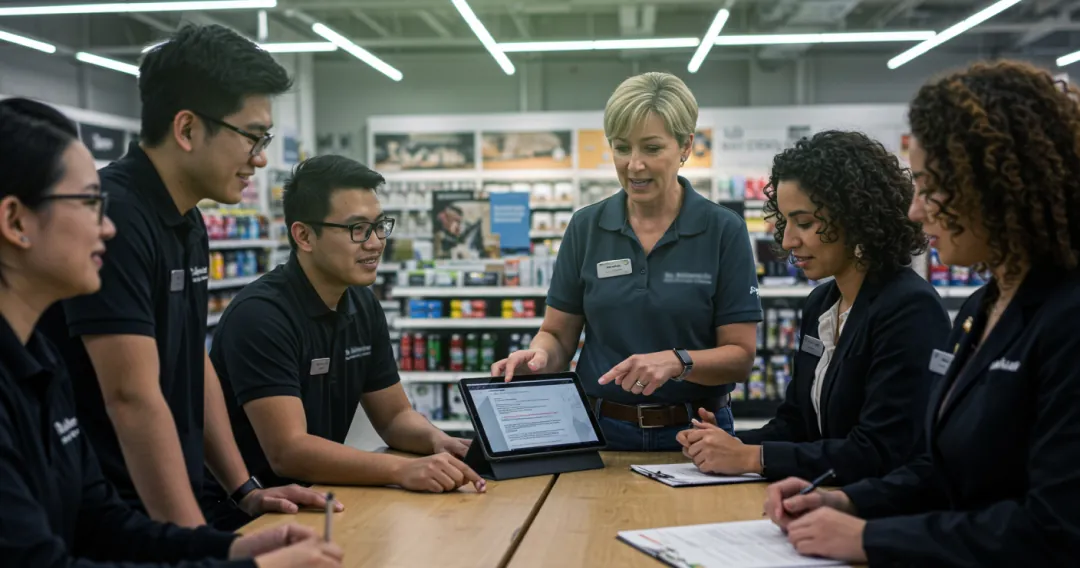Key Takeaways:
-
- Effective loss prevention hinges on five key points: Culture, People, Data, Technology, and Action.
- A strong loss prevention culture requires leadership commitment and employee engagement.
- Empowering and training employees to identify and report suspicious activity is essential.
- Data analysis provides insights into loss trends, enabling targeted prevention efforts.
- Technology solutions enhance security and streamline loss prevention processes.

5 Points of Loss Prevention Explained
Point 1: Cultivating a Culture of Loss Prevention
A strong loss prevention culture starts at the top, with leadership demonstrating a commitment to ethical behavior and asset protection. This commitment must be communicated throughout the organization, creating a shared understanding of the importance of loss prevention.
Key elements of a strong loss prevention culture include:
-
- Clear Policies and Procedures: Establish clear guidelines for handling cash, managing inventory, and responding to suspicious activity.
- Open Communication: Encourage employees to report concerns or suspicions without fear of retaliation.
- Ethical Leadership: Lead by example, demonstrating integrity and ethical behavior in all business dealings.
- Accountability: Hold employees accountable for following loss prevention policies and procedures.
- Recognition and Rewards: Acknowledge and reward employees who contribute to loss prevention efforts.
Point 2: Empowering People as Loss Prevention Champions
Employees are the eyes and ears of a retail business, making them a crucial part of the loss prevention strategy. Empowering employees to identify and report suspicious activity can significantly reduce losses.
Strategies for empowering employees include:
-
- Comprehensive Training: Provide training on shoplifting awareness, internal theft prevention, and proper security procedures.
- Clear Reporting Channels: Establish clear and confidential channels for employees to report concerns or suspicions.
- Incentive Programs: Consider offering incentives for employees who identify or prevent theft.
- Respectful Treatment: Treat employees with respect and create a positive work environment, which can reduce the risk of internal theft.
- Ongoing Communication: Keep employees informed about loss prevention trends and successes.
Point 3: Leveraging Data for Informed Decision-Making
Data analysis provides valuable insights into loss trends, enabling retailers to target their prevention efforts effectively. By analyzing data from various sources, retailers can identify patterns and anomalies that may indicate theft, fraud, or errors.
Key data sources for loss prevention include:
-
- Point-of-Sale (POS) Data: Analyze transaction data for irregularities, such as excessive discounts or returns.
- Inventory Management Systems: Track inventory levels and identify discrepancies between expected and actual stock.
- Exception-Based Reporting (EBR): Analyze transaction data to identify unusual patterns or anomalies.
- Video Surveillance Data: Review video footage to identify shoplifting incidents or suspicious behavior.
- Incident Reports: Track reported incidents of theft, fraud, or other losses.
Point 4: Implementing Technology Solutions for Enhanced Security
Technology plays a vital role in modern loss prevention, enhancing security and streamlining processes. Various technology solutions can help retailers prevent and detect losses:
-
- Video Surveillance Systems: Monitor store activity and provide evidence of theft or fraud.
- Electronic Article Surveillance (EAS) Systems: Prevent shoplifting by triggering alarms when tagged merchandise is removed from the store.
- Access Control Systems: Restrict access to sensitive areas, such as stockrooms or cash offices.
- Inventory Management Systems: Track inventory levels and identify discrepancies in real time.
- Data Analytics Software: Analyze data from various sources to identify loss trends and patterns.
Point 5: Taking Action to Prevent and Mitigate Losses
The first four points of loss prevention are essential, but they are only effective if they lead to action. Retailers must be prepared to take swift and decisive action to prevent and mitigate losses.
Actionable steps include:
-
- Investigating Suspicious Activity: Thoroughly investigate any reported incidents of theft, fraud, or other losses.
- Implementing Corrective Measures: Take steps to address vulnerabilities and prevent future losses.
- Enforcing Policies and Procedures: Consistently enforce loss prevention policies and procedures.
- Working with Law Enforcement: Collaborate with law enforcement to prosecute offenders and deter future crime.
- Continuously Evaluating and Improving: Regularly evaluate the effectiveness of loss prevention efforts and make adjustments as needed.
How ThinkLP Supports Loss Prevention
ThinkLP offers a complex suite of features to manage all aspects of loss prevention, including incident reporting, case management, and data analytics. Retailers can consolidate data from various sources, streamline incident reporting, and conduct in-depth investigations with ThinkLP. The platform’s analytics capabilities help identify trends and patterns, enabling retailers to proactively address vulnerabilities and reduce losses. ThinkLP’s smart audit solutions also ensure compliance and drive actions based on audit responses.
Final Thoughts
Effective loss prevention is an ongoing process that requires a comprehensive and integrated approach. By focusing on these five key points – Culture, People, Data, Technology, and Action – retailers can minimize losses, protect their assets, and improve their bottom line. A proactive and data-driven approach, combined with a strong commitment from leadership and engaged employees, is essential for success in the ever-evolving retail landscape.
Explore ThinkLP’s Blog
Now that you know about the 5 points of loss prevention, you can find additional insights on loss prevention and safety intelligence on ThinkLP’s blog. The blog features articles, case studies, and industry insights that provide practical tips and strategies for improving your loss prevention efforts.
Request a Demo
If you are interested in how ThinkLP’s software can support your loss prevention initiatives, we invite you to request a demo. Their Loss & Safety Intelligence Platform is designed to integrate with your existing operations, helping you reduce risks and improve efficiency. Reach out today to learn how ThinkLP can assist your organization in optimizing its loss prevention strategy.


